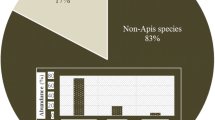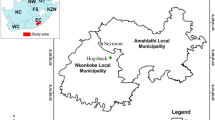Abstract
To evaluate the effect of the carpenter bee, Xylocopa olivacea Lepeletier 1841, on the pod and seed yields of Phaseolus coccineus L., in this study, its foraging and pollination activities were examined in Ngaoundéré during the June-July 2010 and July-August 2011 cropping seasons. Treatments included open floral access to all visitors, bagging of flowers to avoid all visits and floral access to limited visits of X. olivacea. Observations were made on 120 flowers per treatment. In addition, all flower visitors were recorded. The seasonal rhythm of the activity of the carpenter bee, its foraging behaviour on flowers and its pollination efficiency (fruiting rate, number of seeds/pod and percentage of normal or well-developed seeds) were recorded. Phaseolus coccineus flowers were visited by 13 insect species in 2010 and by 14 insect species in 2011. Xylocopa olivacea was the most frequent visitor and intensely and exclusively foraged the flowers for nectar. The mean foraging speed was 9.28 flowers/min. In 2010, the foraging activity of X. olivacea resulted in a significant increase in the fruiting rate (27.49%), number of seeds/pod (45.43%) and percentage of normal seeds (89.38%). In 2011, the corresponding values were 56.14% (fruiting rate), 74.44% (number of seeds/pod) and 66.44% (percentage of normal seeds). These results reveal that this crop experiences a pollination deficit, considering that flowers visited by X. olivacea had higher yields than those under unlimited access to all visitors. Hence, the conservation of X. olivacea nests close to P. coccineus crop fields is recommended for improving pod and seed production.
Similar content being viewed by others
References
Azoó M. E., Tchuenguem Fohouo E-N. and Messi J. (2011) Influence of the foraging activity of the entomofauna on okra (Abelmoschus esculentus) seed yield. International Journal of Agriculture and Biology 13, 761–765.
Backhaus W. (1993) Colour vision and colour choice behaviour of the honey bee. Apidologie 24, 309–331.
Basualdo M., Bedascarrasbure E. and De Jong D. (2000) Africanized honey bees (Hymenoptera: Apidae) have a greater fidelity to sunflowers than European bees. Journal of Economic Entomology 93, 304–307.
Blackwall E L. C. (1971) A study of plant/insect relationships and setting in the runner bean (Phaseolus multiflorus). Journal of Horticultural Science 46, 365–379.
Darwin C. (1876) The Effects of Cross and Self Fertilization in the Vegetable Kingdom. John Murray, London. 505 pp.
Demarly Y. (1977) Génétique et amélioration des fiantes. Masson, Paris. 577 pp.
Douka O. and Tchuenguem Fohouo E-N. (2013) Foraging and pollination behavior of Afis mellifera adansonii L. (Hymenoptera: Apidae) onPhaseolus vulgaris (Fabaceae) flowers at Maroua (Cameroon). International Research Journal of Plant Science 4, 45–54.
Dounia O. and Tchuenguem Fohouo E-N. (2013) Foraging and pollination activity of Apis mellifera adansonii Latreille (Hymenoptera: Apidae) on flowers of Gossypium hirsutum L. (Malvaceae) at Maroua, Cameroon. International Research Journal of Plant Science 4, 33–44.
Fameni Tope S., Tchuenguem Fohouo F.-N. and Brückner D. (2012) Pollination efficiency of Apis mellifera adansonii (Hymenoptera, Apidae) on Callistemon rigidus (Myrtaceae) flowers at Dang (Ngaoundéré, Cameroon). International Journal of Tropical Insect Science 32, 2–11.
Fluri P. and Frick R. (2005) L’apiculture en Suisse: état et perspectives. Revue Suisse d’Apiculture 37, 81–86.
Free J. B. (1966) The pollination of the beans Phaseolus multiflorus and Phaseolus vulgaris by honey bees. Journal of Apicultural Research 5, 87–91.
Free J. B. (1970) Insect Pollination of Crops, 1st edn. Academic Press, London. 544 pp.
Free J. B. (1993) Insect Pollination of Crops, 2nd edn. Academic Press, London. 768 pp.
Freitas B. M. (1997) Number and distribution of cashew (Anacardium occidentale) pollen grains on the bodies of its pollinators, Apis mellifera and Centris tarsata. Journal of Apicultural Research 36, 15–22.
Gallai N., Salles J. M., Settele J. and Vaissière B. E. (2009) Economic valuation of the vulnerability of world agriculture confronted with pollinator decline. Ecological Economics 68, 810–821.
Gupta D. N., Parab A. A., Mehta H. R. and Goyal R. (2001) Evaluation of nutritive value of promising genotypes and horsegram in Konkan. Journal of Phytological Research 14, 143–146.
Heslop-Harrison J. and Heslop-Harrison Y. (1983) Stigma organisation and the control of fertilisation in Phaseolus, pp. 88–96. In EUCARPIA Symposium Proceedings on Phaseolus Breeding, 19–21 July 1983, Hamburg (edited by J. Reimann-Phillips), pp. 88–96.
Ibarra-Perez R J., Barnhart D., Ehdaie B., Rnio K. M. and Waines J. G. (1999) Effects of insect tripping on seed yield of common bean. Crop Science 39, 428–433.
Ibrahim A. M. and Coyne D. P. (1975) Genetics of stigma shape, cotyledon position and flower color in reciprocal crosses between Phaseolus vulgaris L. and Phaseolus coccineus (Lam) and implications in breeding. Journal of the American Society for Horticultural Science 100, 622–626.
Jacob-Remacle A. (1989) Comportement de butinage de l’abeille domestique et des abeilles sauvages dans des vergers de pommiers en Belgique. Apidologie 20, 271–285.
Jean-Prost P. (1987) Knowing the Bees-Leading the Hives, 6th edn. Lavoisier, Paris. 579 pp.
Kaplan L. (1965) Archaeology and domestication in American Phaseolus (beans). Economic Botany 19, 358–368.
Kasina M., Kraemer M., Martius C. and Wittmann D. (2009) Diversity and activity density of bees visiting crop flowers in Kakamega, Western Kenya. Journal of Apicultural Research 48, 134–139.
Kasper M. L., Reeson A. R., Mackay D. A. and Austin A. D. (2008) Environmental factors influencing daily foraging activity of Vespula germanica (Hymenoptera, Vespidae) in Mediterranean Australia. Insectes Sociaux 55, 288–296.
Keller L. R and Waller D. M. (2002) Inbreeding effects in wild populations. Trends in Ecology and Evolution 17, 230–241.
Kendal D. A. and Smith B. D. (1976) The pollinating efficiency of honey bee and bumblebee visits to flowers of runner bean Phaseolus coccineus. Journal of Applied Ecology 133, 749–752.
Klein A. M., Vaissière B. E., Cane J. H., Steffan-Dewenter I., Cunningham S. A., Kremen C. and Tscharntke T. (2007) Importance of pollinators in changing landscapes for world crops. Proceedings of the Royal Society B 274, 303–313.
Koltowski Z. (2004) Flowering biology, nectar secretion and insect foraging of runner bean (Phaseolus coccineus L.). Journal of Apicultural Science 48, 53–60.
Louveaux J. (1984) L’abeille domestique dans ses relations avec les plantes cultivées, pp. 527–555. In Pollinisation et productions végétales (edited by P. Pesson and J. Louveaux). INR A, Paris.
Maréchal R., Mascherpa J. M. and Stainier F. (1978) Etude taxonomique d’un groupe complexe d’espèces des genres Phaseolus (Fabaceae) et Vigna (Papilionaceae) sur la base de données morphologiques et polliniques traitées par l’analyse informatique. Boissiera 28, 1–273.
Mazi S., Tchuenguem F.-N. and Brückner D. (2013) Foraging and pollination behaviour of Apis mellifera adansonii Latreille (Hymenoptera, Apidae) on Gossypium hirsutum (Malvaceae) flowers at Dang (Ngaoundéré, Cameroon). Journal of Agricultural Science and Technology 3, 267–280.
Mensah B. A. and Kudom A. A. (2010) Relating bee activity to pollination of Luffa aegyptiaca Mill, in Ghana. Journal of Apicultural Research 49, 192–196.
Mensah B. A. and Kudom A. A. (2011) Foraging dynamics and pollination efficiency of Apis mellifera and Xylocopa olivacea on Luffa aegyptiaca Mill. (Cucurbitaceae) in Southern Ghana. Journal of Pollination Ecology 4, 34–38.
Oscar J. R. and Stephenson A. G. (1991) Effect of nonrandom seed abortion on progeny performance in Phaseolus coccineus L. Evolution 45, 1198–1208.
Palmer R. (1967) Bees and bean pollination. South African Bee Journal 39, 12–13.
Pando J. B., Tchuenguem Fohouo F.-N. and Tamesse J. L. (2011a) Foraging and pollination behaviour of Xylocopa calens (Hymenoptera: Apidae) on Phaseolus coccineus L. (Fabaceae) flowers at Yaoundé (Cameroon). Entomological Research 41, 185–193.
Pando J. B., Tchuenguem Fohouo F.-N. and Tamesse J. L. (2011b) Pollination and yield responses of pigeon pea (Cajanus cajan L. Millsp.) to the foraging activity of Chalicodoma cincta cincta (Hymenoptera: Megachilidae) in Yaoundé (Cameroon). Journal of Animal and Plant Sciences 11, 1346–1357.
Proctor M., Yeo P. and Lack A. (1996) The Natural History of Pollination (edited by S. A. Corbet, S. M. Walters, W. Richard, D. Streeter and D. A. Ratcliffe). Harper Collins, London. 462 pp.
Roubik D. W. (2000) Pollination system stability in tropical America. Conservation Biology 14, 1235–1236.
Sabbahi R., De Oliveira D. and Marceau J. (2005) Influence of honey bee (Hymenoptera: Apidae) density on the production of canola (Crucifera: Brassicaceae). Journal of Economic Entomology 2, 367–372.
Schneider S. S. and Hall H. G. (1997) Diet selection and foraging distances of African and European-African hybrid honey bee colonies in Costa Rica. Insectes Sociaux 44, 171–187.
Tchuenguem Fohouo F.-N. (2005) Activité de butinage et de pollinisation d’Apis mellifera adansonii Latreille (Hymenoptera: Apidae, Apinae) sur les fleurs de trois plantes à Ngaoundéré (Cameroun): Callistemon rigidus (Myrtaceae), Sygygium guineense var. macrocarpum (Myrtaceae) et Voacanga africana (Apocynaceae). Thèse du Doctorat d’Etat, Université de Yaoundé I, Yaoundé, Cameroon. 103 pp.
Tchuenguem Fohouo F.-N., Djonwangwe D., Messi J. and Brückner D. (2007) Exploitation of Entada africana, Eucalyptus camaldulensis, Psidium guajava and Trichilia emetica flowers by Apis mellifera adansonii at Dang (Ngaoundéré, Cameroon). Cameroon Journal of Experimental Biology 3, 50–60.
Tchuenguem Fohouo F.-N., Djonwangwe D., Messi J. and Brückner D. (2008a) Exploitation of Dichrostachys cinerea, Vitellaria paradoxa, Persea americana and Securidaca longepedunculata flowers by Apis mellifera adansonii Latreille (Hymenoptera: Apidae) at Dang (Ngaoundéré, Cameroon). International Journal of Tropical Insect Science 28, 225–233.
Tchuenguem Fohouo F.-N., Djonwangwe D. and Brückner D. (2008b) Foraging behaviour of the African honey bee (Apis mellifera adansonii) on Annona senegalensis, Croton macrostachyus, Psorospermum febrifugum and Syzygium guineense var. guineense flowers at Ngaoundéré (Cameroon). Pakistan Journal of Biological Sciences 11, 719–725.
Tchuenguem Fohouo E-N., Fameni Tope S., Mbianda Pharaon A., Messi J. and Brückner D. (2010) Foraging behaviour of Apis mellifera adansonii (Hymenoptera: Apidae) on Combretum nigricans, Erythrina sigmoidea, Lannea kerstingii and Vernonia amygdalina flowers at Dang (Ngaoundéré, Cameroon). International Journal of Tropical Insect Science 30, 40–47.
Tchuenguem Fohouo F.-N., Messi J., Brückner D., Bouba B., Mbofung G. and Hentchoya Hemo J. (2004) Foraging and pollination behaviour of the African honey bee (Apis mellifera adansonii) on Callistemon rigidus flowers at Ngaoundéré (Cameroon). Journal of the Cameroon Academy of Sciences 4, 133–140.
Tchuenguem Fohouo F.-N., Messi J. and Pauly A. (2001) Activité de Meliponula erythra sur les fleurs de Dacryodes edulis et son impact sur la fructification. Fruits 56, 179–188.
Tchuenguem F. F.-N., Djonwangwe D., Messi J. and Brückner D. (2009a) Activité de butinage et de pollinisation de Apis mellifera adansonii sur les fleurs de Helianthus annuus (Asteraceae) à Ngaoundéré (Cameroun). Cameroon Journal of Experimental Biology 5, 1–9.
Tchuenguem Fohouo F.-N., Ngakou A. and Kengni B. S. (2009b) Pollination and yield responses of cowpea (Vigna unguiculata L. Walp.) to the foraging activity of Apis mellifera adansonii (Hymenoptera: Apidae) at Ngaoundéré (Cameroon). African Journal of Biotechnology 8, 1988–1996.
Tuell J. K. and Isaacs R. (2010) Weather during bloom affects pollination and yield of highbush blueberry. Journal of Economic Entomology 103, 557–562.
Vanderborght I. and Rasmont P. (1987) Utilisation de l’abeille domestique (Apis mellifera L.) et de la xylocope (Xylocopa bariwal Maidl) (Hymenoptera, Apidae) pour la pollinisation en cage de Phaseolus coccineus L. Bulletin de Recherche Agronomique de Gembloux 22, 279–284.
Webster B. D., Ross R. M. and Evans T. (1982) Nectar and nectary of Phaseolus vulgaris L. Journal of American Society for Horticultural Science 107, 497–503.
Wells W. C., Isom W. H. and Waines J. G. (1988) Outcrossing rates of six common bean lines. Crop Science 28, 177–178.
Williams I. H. and Free J. B. (1975) The pollination and set of the early flowers of runner bean (Phaseolus multiflorus L.). Journal of Horticultural Science 50, 405–413.
Author information
Authors and Affiliations
Corresponding author
Rights and permissions
About this article
Cite this article
Fohouo, FN.T., Tope, S.F. & Brückner, D. Foraging and pollination behaviour of Xylocopa olivacea (Hymenoptera: Apidae) on Phaseolus coccineus (Fabaceae) flowers at Ngaoundéré (Cameroon). Int J Trop Insect Sci 34, 127–137 (2014). https://doi.org/10.1017/S1742758414000241
Accepted:
Published:
Issue Date:
DOI: https://doi.org/10.1017/S1742758414000241




